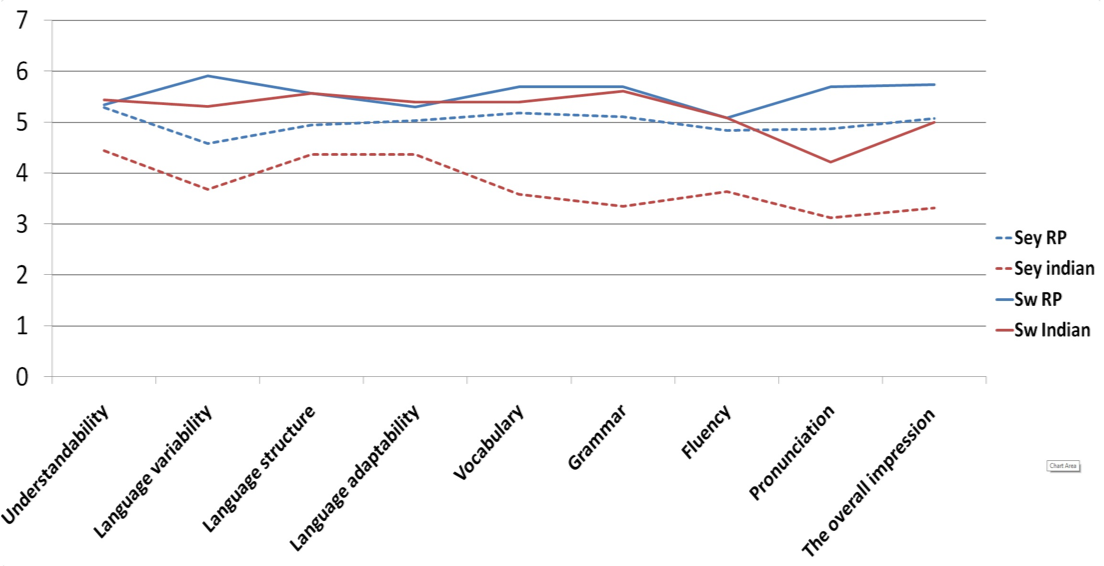Indian English vs British RP
| ||||||||||
| indian_vs_rp_script.pdf |
Recording and Manipulation
The script was recorded using a bi-dialectal speaker who spoke both standard received pronunciation British English (RP), as well as Indian English. We recorded the RP-version first and then used a karaoke-like method to ensure that they were identical (including pausing, uhms and ahs etc.). We also used digital manipulation to align speech rates and intensity levels of the recordings
The script was recorded using a bi-dialectal speaker who spoke both standard received pronunciation British English (RP), as well as Indian English. We recorded the RP-version first and then used a karaoke-like method to ensure that they were identical (including pausing, uhms and ahs etc.). We also used digital manipulation to align speech rates and intensity levels of the recordings
|
Version A: British RP
|
Version B: Indian English
|
Presenting and Conducting the Case
To hide the real purpose of the exercise, it was initially contextualised as a workshop on evaluation, where the respondents (teacher trainees and active teachers) were told they would listen to an oral presentation performed by an adult student, and evaluate the language performance of the same. They were not aware of the fact that there were two versions of the recording at this stage. Respondents were also told that their responses would form the basis of a follow-up seminar discussion, where evaluations of the “student” would be in focus.
To hide the real purpose of the exercise, it was initially contextualised as a workshop on evaluation, where the respondents (teacher trainees and active teachers) were told they would listen to an oral presentation performed by an adult student, and evaluate the language performance of the same. They were not aware of the fact that there were two versions of the recording at this stage. Respondents were also told that their responses would form the basis of a follow-up seminar discussion, where evaluations of the “student” would be in focus.

Want to try?
If you want to try out the case with your own class use QR-code is link below for a ready package.
https://www.surveymonkey.com/r/SXDYHKC
Note! Contact [email protected] if you want to do this with a group so that we can set up a specific group for you and give you access to the results.
If you want to try out the case with your own class use QR-code is link below for a ready package.
https://www.surveymonkey.com/r/SXDYHKC
Note! Contact [email protected] if you want to do this with a group so that we can set up a specific group for you and give you access to the results.

Link to post-survey. Please let participants answer this after the seminar discussion!
https://www.surveymonkey.com/r/R7N92JX
https://www.surveymonkey.com/r/R7N92JX
|
Example of Debriefing material
|
| ||
Some Results from Previous Trials
We have conducted this case on several occasions with student and teacher groups in Sweden and the Seychelles. As illustrated in Figure 5 above, the Seychelles respondent group in particular have evaluated the versions very differently (in spite of the fact that the only difference between the two is the accent in which the talk is presented). In fact results from workshops conducted so far show that the Indian English is evaluated more negatively on all the variables investigated. The seychelles respondents also evaluated the Indian English version significantly more negatively on the more evaluative statements which touched on aspects such as intelligence, level of education and the quality of the arguments presented. The Swedish respondents have evaluated the two versions reasonably equally except for the variable ‘pronunciation’, where respondents seem to regard Indian English pronunciation as inferior to RP.
We have conducted this case on several occasions with student and teacher groups in Sweden and the Seychelles. As illustrated in Figure 5 above, the Seychelles respondent group in particular have evaluated the versions very differently (in spite of the fact that the only difference between the two is the accent in which the talk is presented). In fact results from workshops conducted so far show that the Indian English is evaluated more negatively on all the variables investigated. The seychelles respondents also evaluated the Indian English version significantly more negatively on the more evaluative statements which touched on aspects such as intelligence, level of education and the quality of the arguments presented. The Swedish respondents have evaluated the two versions reasonably equally except for the variable ‘pronunciation’, where respondents seem to regard Indian English pronunciation as inferior to RP.
Figure 1. Differences between perceptions of language performance conducted in RP (in blue) vs. Indian English (in red) among Seychelles respondents (dotted lines, N=79) and Swedish respondents (whole drawn lines, N=46).
